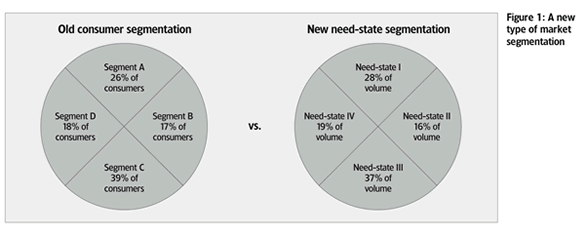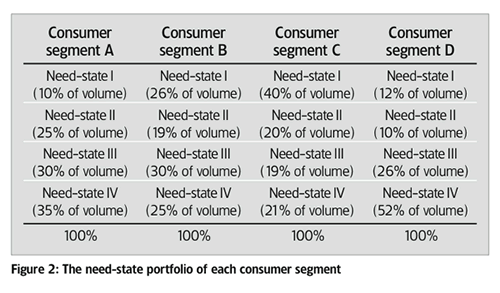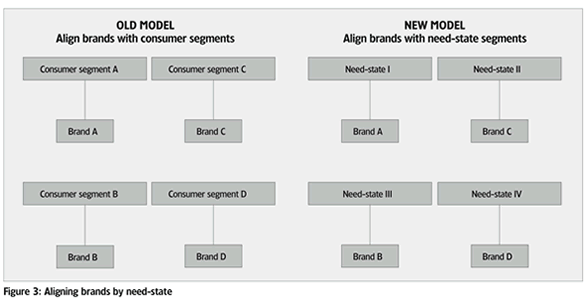The Rise of the Portfolio
by Bruce Tait, for Market Leader (UK) • Published Spring 2004
Everywhere you turn there are signs that the brand marketing approaches developed in the 20th century are becoming less useful in today’s environment. It used to be that monolithic brands could generate a tremendous degree of loyalty from large, homogeneous consumer segments. Coca-Cola could count on won-over consumers loyally ordering Coke virtually every time they wanted a soda. Anheuser-Busch could count on twenty-something beer drinkers choosing Budweiser when they wanted a beer. Today, consumers in mature markets everywhere are far less brand loyal. Rather than relying on one mega-brand to meet all their needs in a category, they are looking for a personal portfolio of brands that can serve different needs at different times.
For many categories, segmenting consumers was never the most productive way to segment the market. Each consumer could have a portfolio of brands that served different need-states.
In a recent trend report, Roper ASW reported that ‘having one brand is increasingly the exception.’ The study looked at 23 categories and found that, in sectors as diverse as toothpaste and soft drinks, the percentage of people having just one favourite brand was dropping significantly. In fact, only 34% of people report being loyal to one brand across the categories studied. That means two-thirds of consumers rotate through a personal portfolio of brands in a particular category. So where a young beer drinker might have been loyal to just one brand 20 years ago, now he or she may consider one brand to be his ‘cool night club beer’, another to be his ‘watching the game on TV beer’ and another his ‘hot weather refreshment beer’.
To deal with a new world where consumers are, in effect, choosing from a personal portfolio of brands, marketers need to consider two changes to the 20th-century marketing canon:
- In this environment, a brand can hope only for a reduced role as one of several options in the consumer’s personal portfolio. In fact, we might want to rethink the way markets are segmented when one consumer is using multiple brands to fulfill a variety of need-states.
- The role of the brand manager should be rethought as companies need more than one brand to surround a customer and capture significant share. Perhaps companies need to create portfolio managers focused on orchestrating a group of brands (or a brand family) to address a variety of consumer-stratified need-states, rather than hoping to gain share with a number of independent brand managers, all trying in vain to ‘own’ a consumer segment.
Market segmentation
In the old world, most brand managers segmented markets by segmenting consumers. The underlying question was, ‘Who do we want to be a Bud (or Coke, or Kit Kat) loyalist?’ Research companies developed more and more sophisticated psychographic segmentation so that a brand could align itself with the values and lifestyle aspirations of its target. In the 1990s, many companies prided themselves on a more consumer-centric approach that celebrated their target segment.
However, for many categories, segmenting consumers was never the most productive way to segment the market. These categories faced a world more like the one many of us find ourselves in today. They found that each consumer could have a personal portfolio of brands that served different need-states. For example, restaurants discovered that one type of consumer will frequent different restaurant brands to serve different needs/occasions – for example, one brand for a romantic evening and another for food in a hurry.
Recently, marketers in a variety of categories have addressed need-states rather than types of consumer with good success. For instance, Kit Kat seems to have defined a need-state (when you need a little break in the day) that they could offer to any consumer. Indeed, the ‘little break’ need-state can transcend consumer segments by fitting into the portfolios of a variety of people. Corona seems to have quickly discovered the shifting dynamics of beer brand loyalty and targeted the ‘relaxing refreshment’ need-state rather than a consumer group. It cleverly shies away from showing us too much about its user group in its advertising (shot only from the back) as this need-state transcends consumer segments. Corona has enjoyed steady growth with this approach.

A need-state segmentation can identify the key need-states in the category and measure the relative volume that each satisfies (across all consumer segments). This type of market segmentation does not necessarily have to involve consumer segments at all. In the most extreme case, it may be more instructive for the brand portfolio manager to understand which need-states exist and which are most attractive from a volume perspective. Then he or she can align the right brand with the right need-state without ever really considering consumer segments (see Figure 1).
Of course, the old and new approaches might best be combined so that psychographic, life-stage or other consumer segments can be checked against need-states to define the need-state portfolio of each consumer segment (see Figure 2).
With this type of information, a portfolio manager may identify that a specific brand should target need-state I, but that consumer segment C should perhaps be the focus of media dollars. We find that while consumer segmentation may still be useful, it seems that segmenting the need-states in your category and creating a portfolio of brands to match against them is more efficient and instructive than simply matching brands with groups of people.

The portfolio manager
In most cases, one brand cannot hope to be elastic enough to serve all need-states, so marketers must manage a portfolio of brands to serve a portfolio of needs. Brand managers might evolve into need-state managers, orchestrated by a portfolio manager.
In order to increase ‘share of throat’, ‘share of wallet’ and so on, a portfolio of offerings needs to be aligned to specific need-states more than it does to specific consumer types. In most cases, one brand cannot hope to be elastic enough to serve all these need-states, so marketers must manage a portfolio of brands to serve a portfolio of needs. Brand managers might evolve into need-state managers, orchestrated by a portfolio manager to ensure that they are focused on one need-state each. Furthermore, a portfolio manager would need to look at the big picture to ensure that the right need-states are being targeted and that multiple brands/products are not unnecessarily fighting each other to serve the same need-state.
Now imagine the advantage a company would gain were it consciously to organise its portfolio around a set of high-volume need-states. It would focus product development and positioning work tremendously. And it would ensure that all key need-states were being targeted by the brand best able to serve them. Brands could then be aligned in a new way against need-state segments rather than consumer segments (see Figure 3).

Conclusion
The world has changed and marketing practice needs to keep up. Consumers have more choices than ever before, and, in most cases, marketers cannot hope to hold on to the complete loyalty of a particular person. For marketers who find themselves in this situation, aligning a portfolio of brands/products with the consumer’s portfolio of need-states is a good solution.
Doing this well could mean a different form of brand management organisation. Brand managers would focus on delivering against a particular consumer need-state, with each brand playing a defined role on the ‘team’. Overseeing them would be a portfolio manager, tasked specifically with increasing overall share.
See All Articles →

